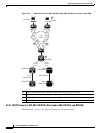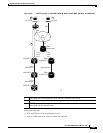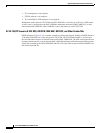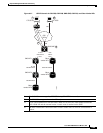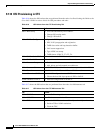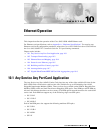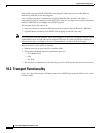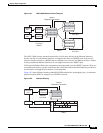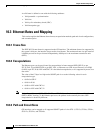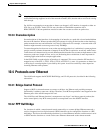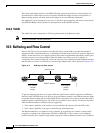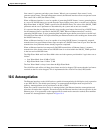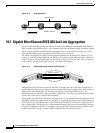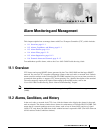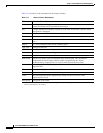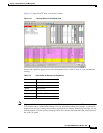
10-4
Cisco ONS 15600 Reference Manual, R7.2
Chapter 10 Ethernet Operation
10.3 Ethernet Rates and Mapping
A valid frame is defined as one with the following attributes:
•
Valid preamble + synchronization
•
Valid size
•
Valid cyclic redundancy check (CRC)
•
Valid interpacket gap
10.3 Ethernet Rates and Mapping
This section explains the Ethernet frame format, encapsulation methods, path and circuit configurations,
and oversubscription.
10.3.1 Frame Size
The IEEE 802.3 frame format is supported on the GE interfaces. The minimum frame size supported by
the system is 64 bytes; the interface drops smaller sized frames. The maximum frame size per interface
is 9600 bytes and can be provisioned independently. 9600 bytes is the maximum transmission unit
(MTU).
10.3.2 Encapsulations
The Ethernet ports can be provisioned for encapsulation in frame-mapped GFP (GFP-F) as per
ITU G.7041, Cisco HDLC/LEX as per RFC 1841, or Ethernet over Link Access Protocol over SDH
(LAPS) as per ITU X.86. LEX with CRC-32 is the default encapsulation, as it is supported by most Cisco
data cards.
The value of the C2 byte in a high-order SONET path is set to the following values for each
encapsulation type:
•
0x1B for GFP-F
•
0x18 for X.86
•
0x05 for LEX with CRC-16
•
0x01 for LEX with CRC-32
Note
Bridge Control Protocol (BCP), HDLC, LEX, and ITU X.86 are all variations of Point-to-Point Protocol
(PPP) in HDLC framing. To the Ethernet processor, the packets look essentially the same. GFP
encapsulation is drastically different.
10.3.3 Path and Circuit Sizes
GE interfaces can be mapped to all supported SONET paths of sizes STS-1, STS-3c, STS-6c, STS-9c,
STS-12c, STS-24c, and STS-48c.



